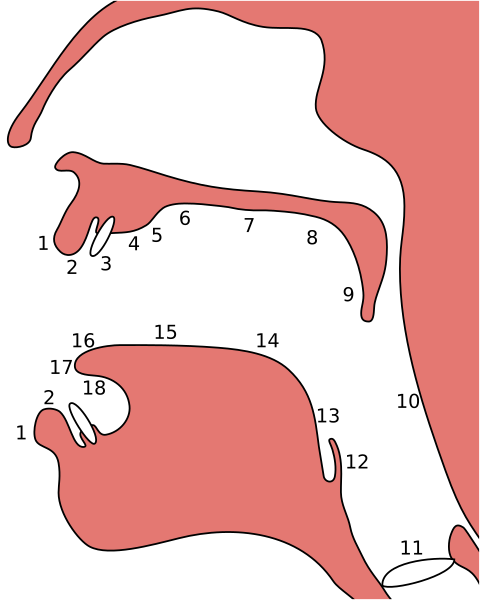Fasciculus:Places of articulation.svg

Size of this PNG preview of this SVG file: 480 × 600 elementa imaginalia. Aliae mensurae: 192 × 240 elementa imaginalia | 384 × 480 elementa imaginalia | 614 × 768 elementa imaginalia | 819 × 1 024 elementa imaginalia | 1 638 × 2 048 elementa imaginalia.
Sua resolutio (fasciculus SVG, nominale 800 × 1 000 elementa imaginalia, magnitudo fasciculi: 32 chiliocteti)
Historia fasciculi
Presso die vel tempore fasciculum videbis, sicut tunc temporis apparuit.
| Dies/Tempus | Minutio | Dimensiones | Usor | Sententia | |
|---|---|---|---|---|---|
| recentissima | 12:50, 11 Martii 2007 |  | 800 × 1 000 (32 chiliocteti) | Rohieb | {{Information |Description={{de|Artikulationsorte}} {{en|Places of articulation}} |Source=this PNG file |Date=2007-03-11 |Author=~~~ |Permission=GNU FDL, CC-BY-SA-2.5 }} |
Nexus ad fasciculum
Ad hunc fasciculum nectunt:
Usus fasciculi per inceptus Vicimediorum
Quae incepta Vici fasciculo utuntur:
- Usus in af.wikipedia.org
- Usus in als.wikipedia.org
- Usus in ar.wikipedia.org
- Usus in ar.wikiversity.org
- Usus in ar.wiktionary.org
- Usus in ast.wikipedia.org
- Usus in ba.wikipedia.org
- Usus in bcl.wikipedia.org
- Usus in bg.wikipedia.org
- Usus in br.wikipedia.org
- Usus in bs.wikipedia.org
- Usus in ca.wikipedia.org
- Usus in da.wikipedia.org
- Usus in de.wikipedia.org
- Zunge
- Konsonant
- Portal:Sprache
- Alveolar
- Uvular
- Velar
- Dental
- Labial
- Palatal
- Pharyngal
- Glottal
- Bilabial
- Artikulationsort
- Labiodental
- Postalveolar
- Artikulation (Linguistik)
- Halbvokal
- Retroflex
- Artikulationsorgan
- Laminal
- Dorsal (Phonetik)
- Zischlaut
- Alveolopalatal
- Labiovelar
- Benutzer:Patrixx/Portal Sprache
- Portal:Linguistik
View more global usage of this file.

